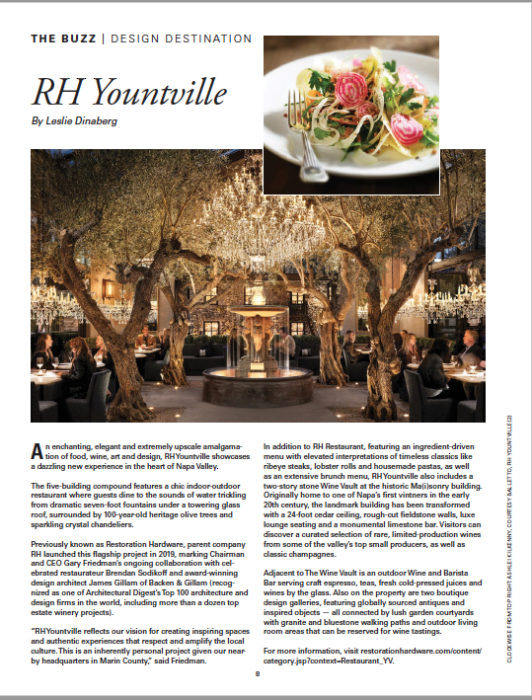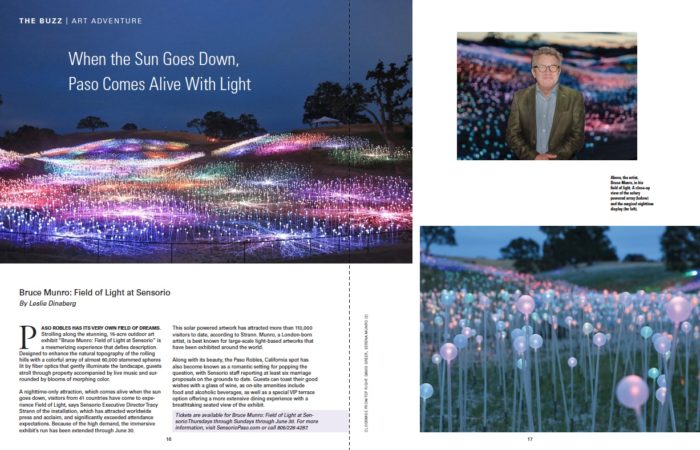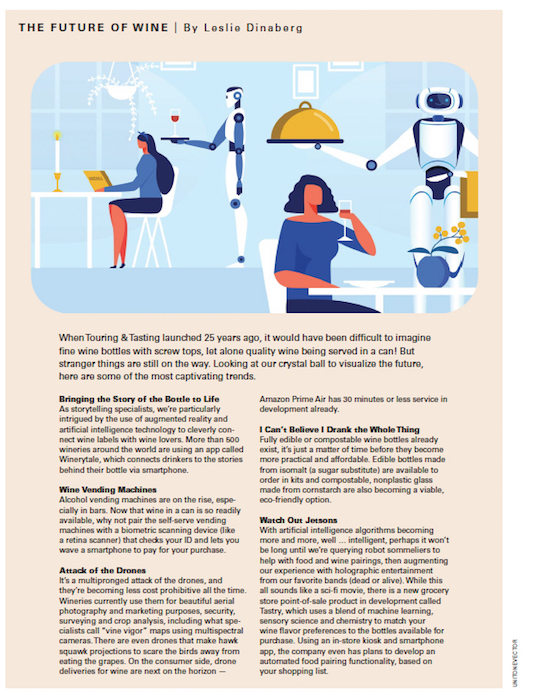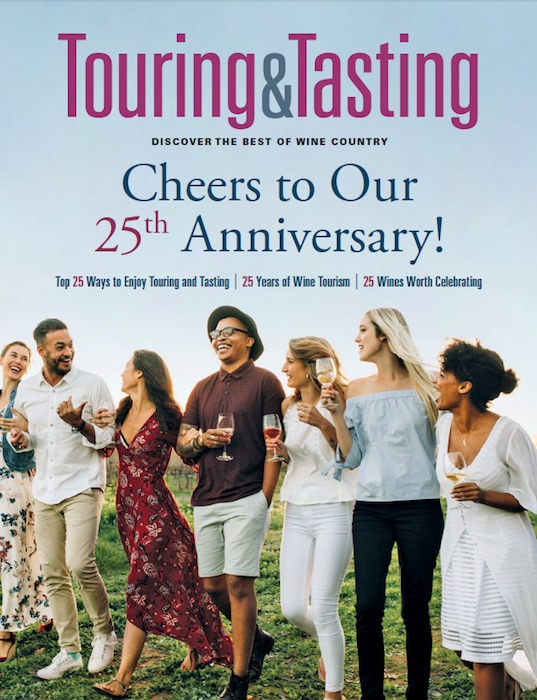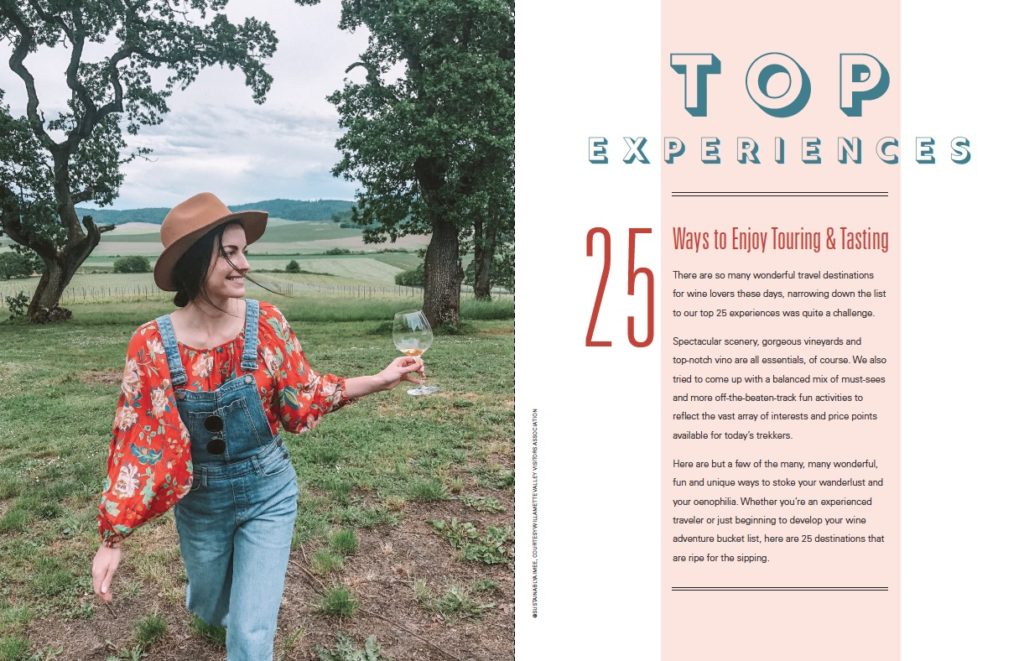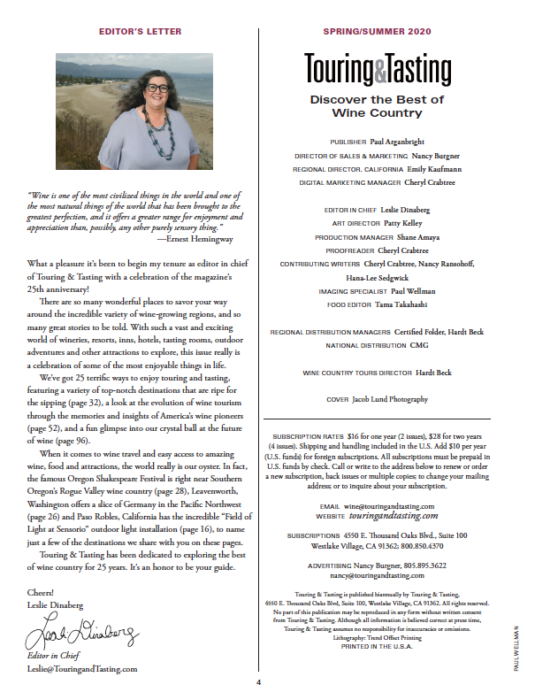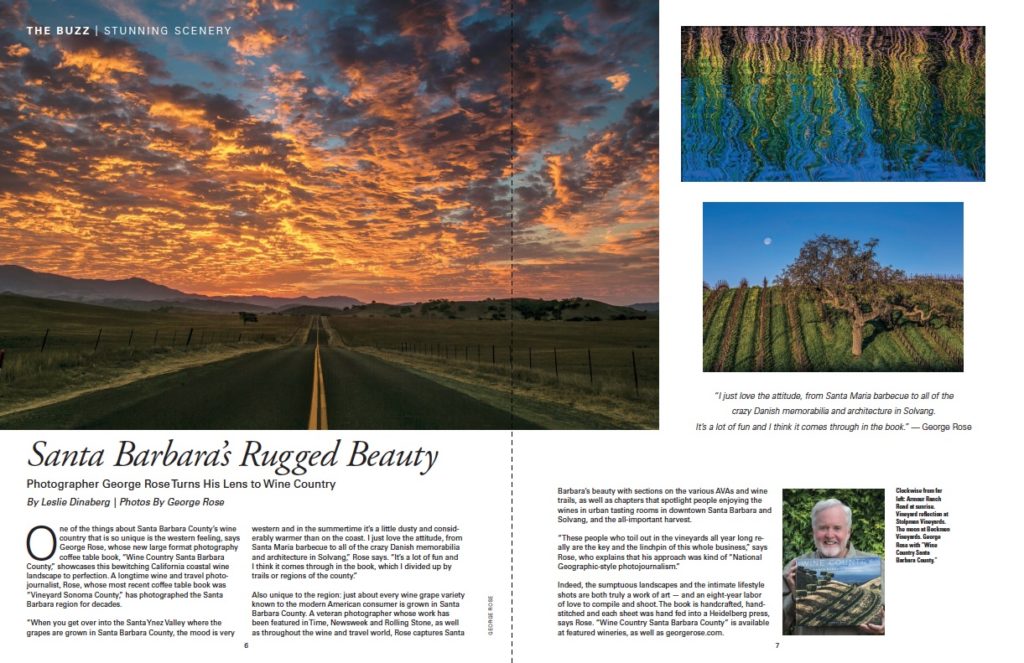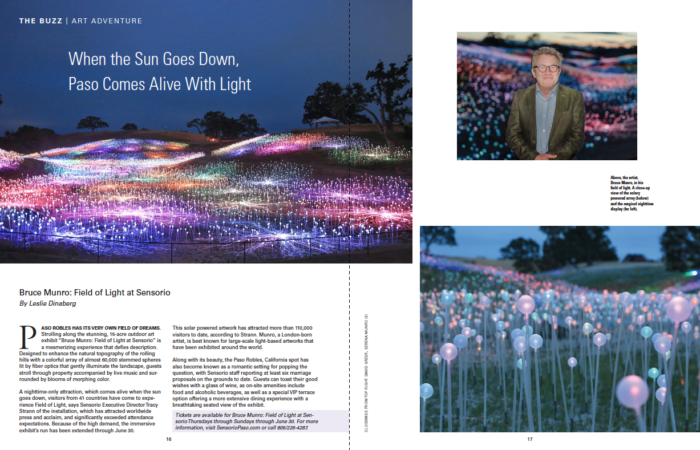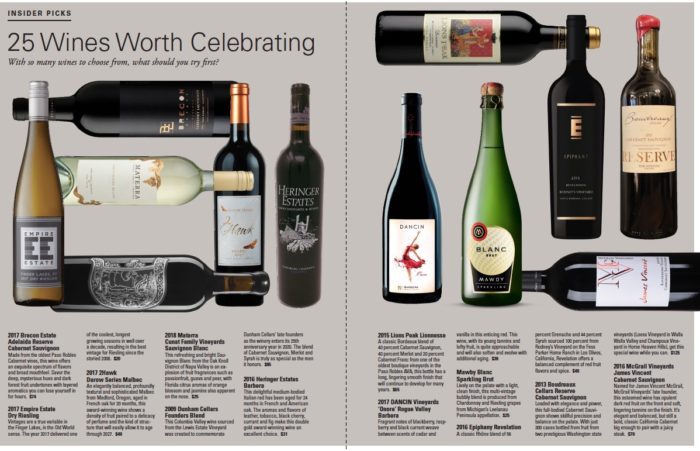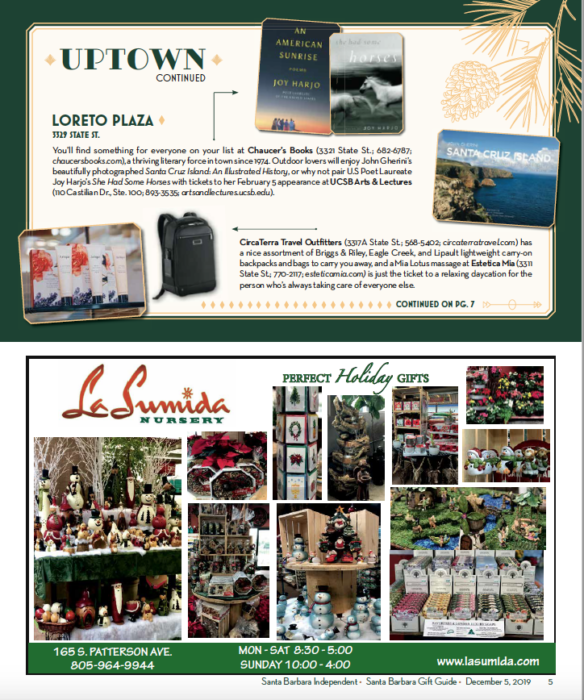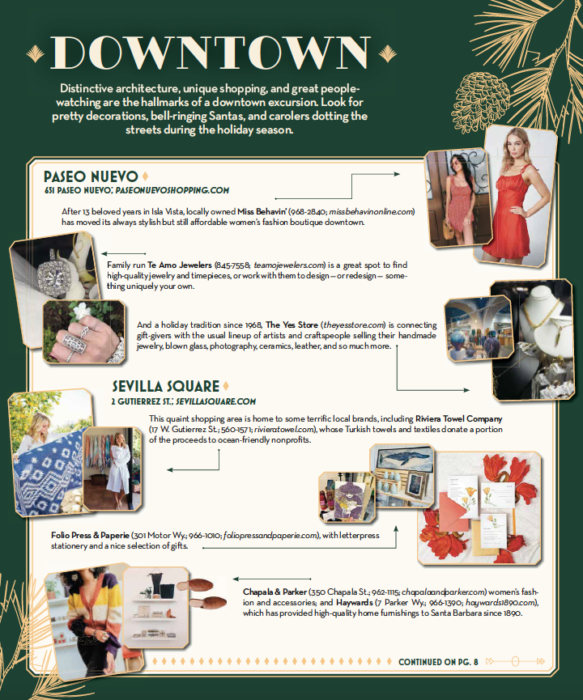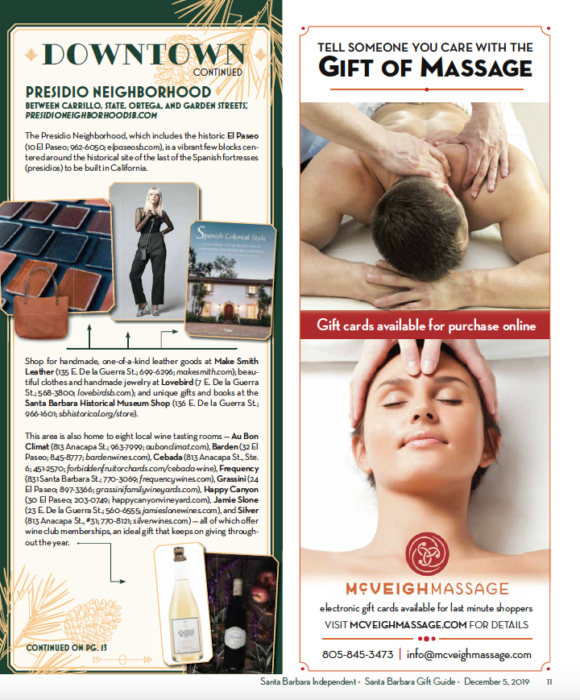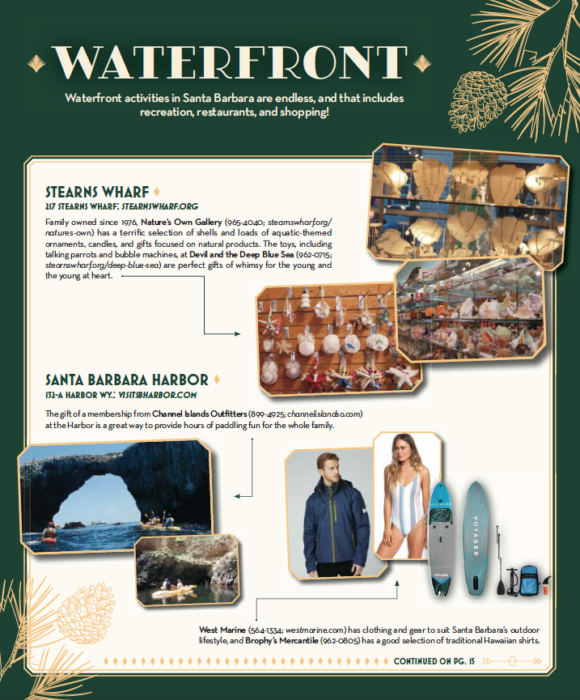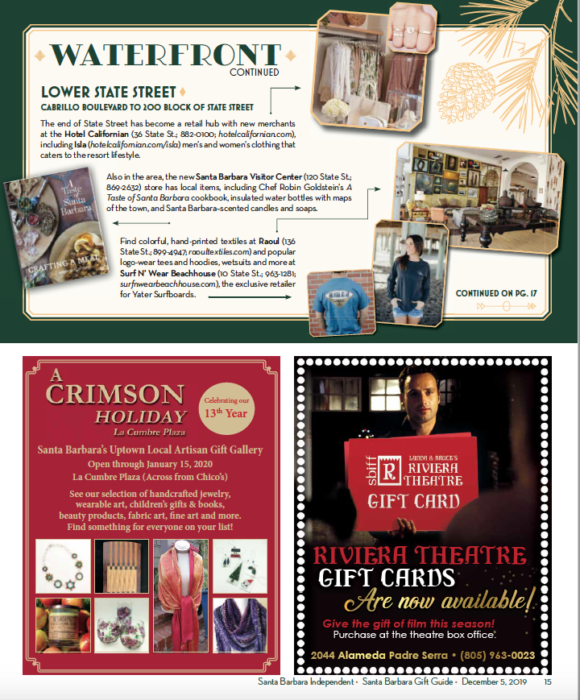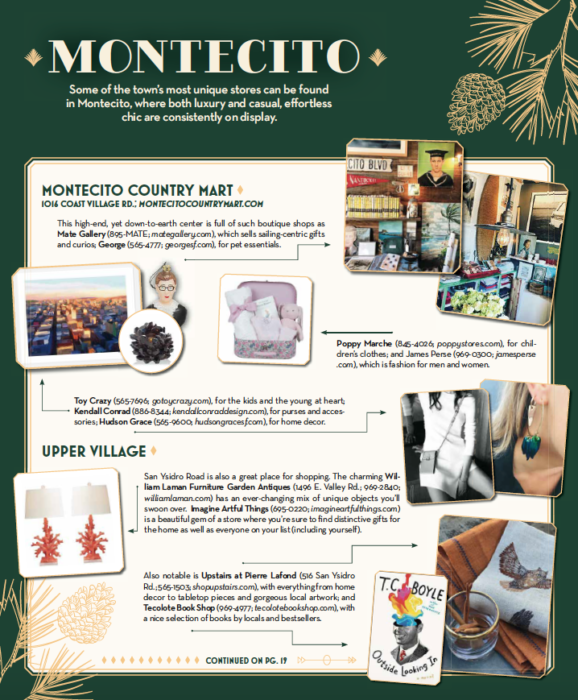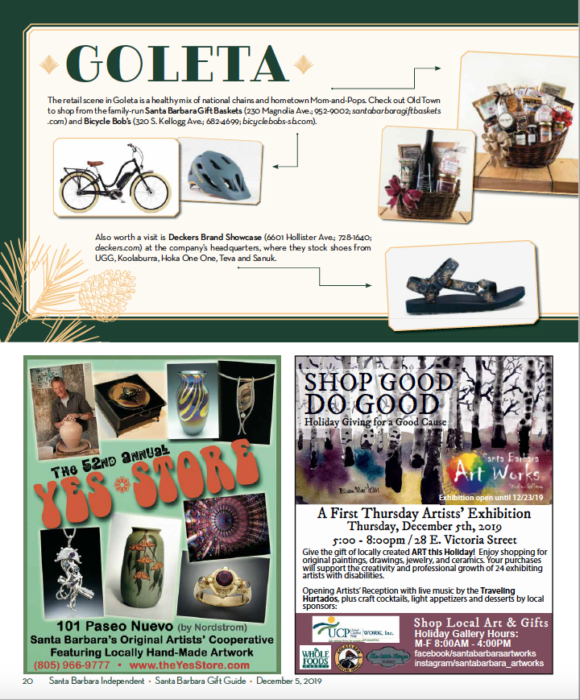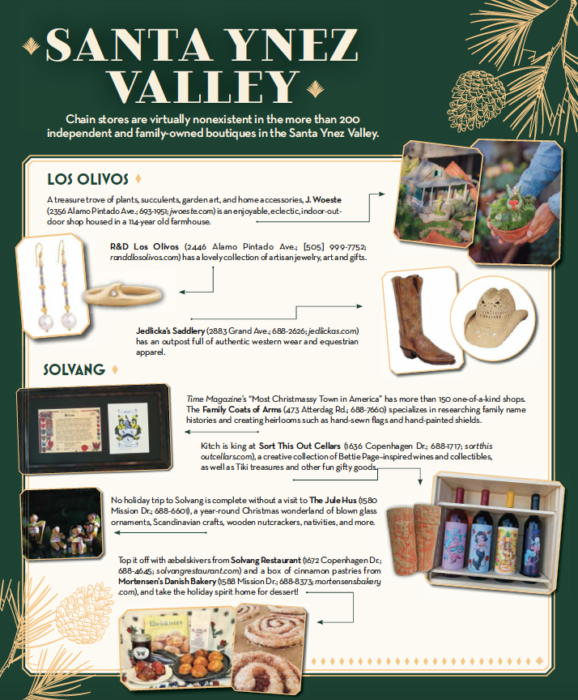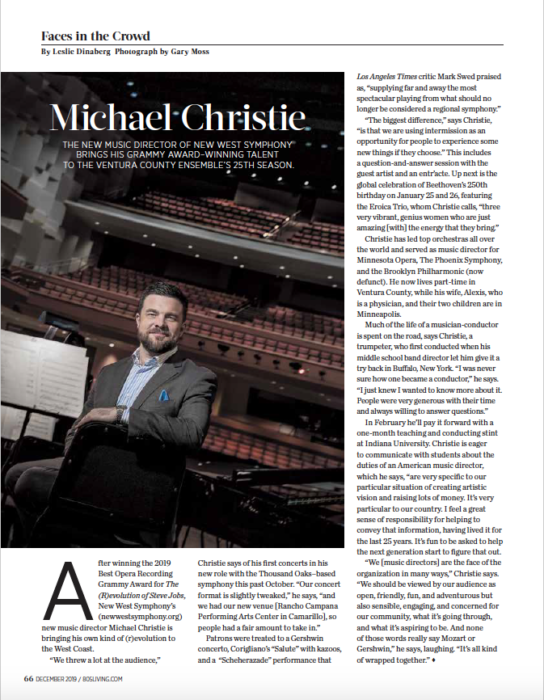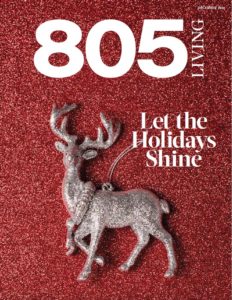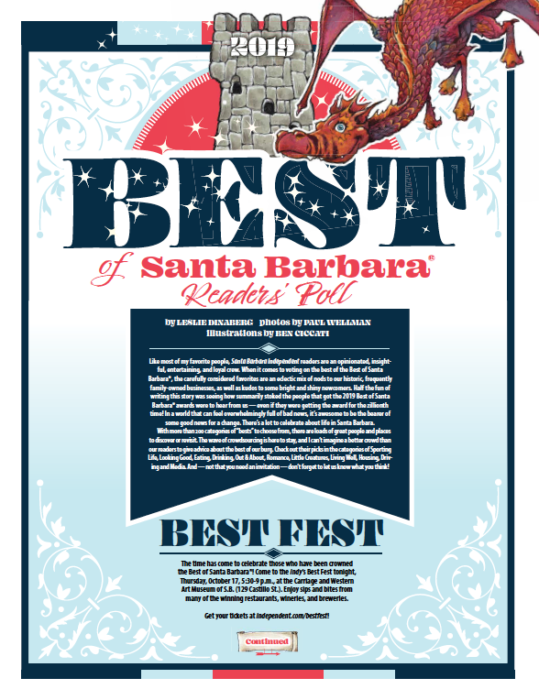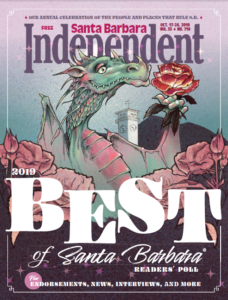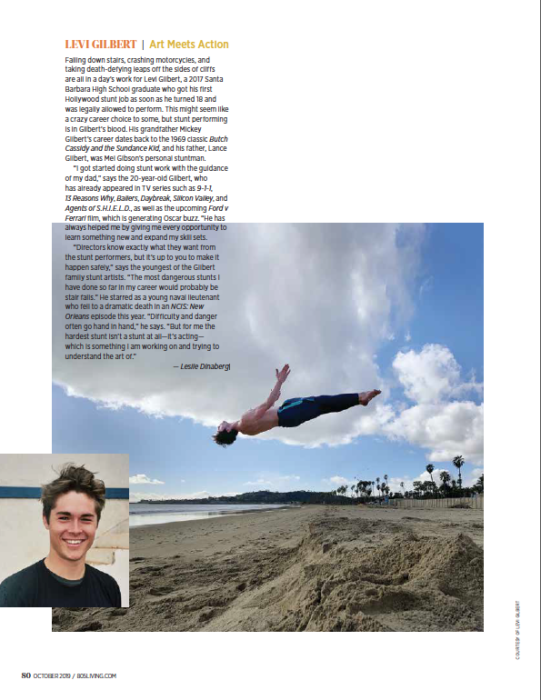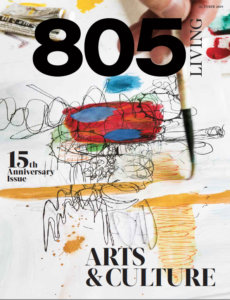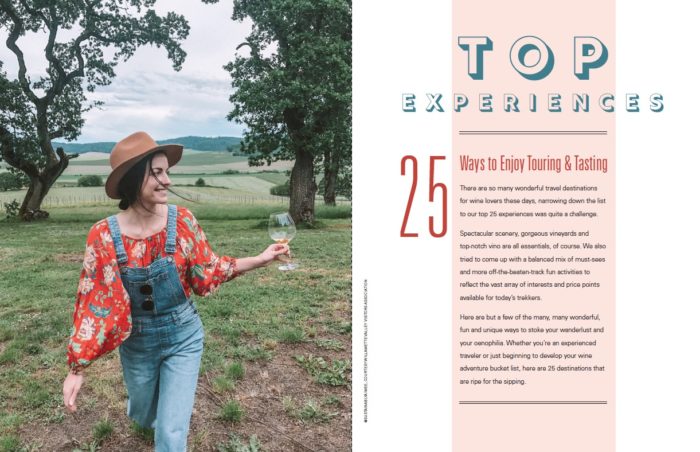
This 25 Top Experiences Feature is a great way to do some armchair traveling! Originally published in the spring/summer 2020 issue of Touring & Tasting.
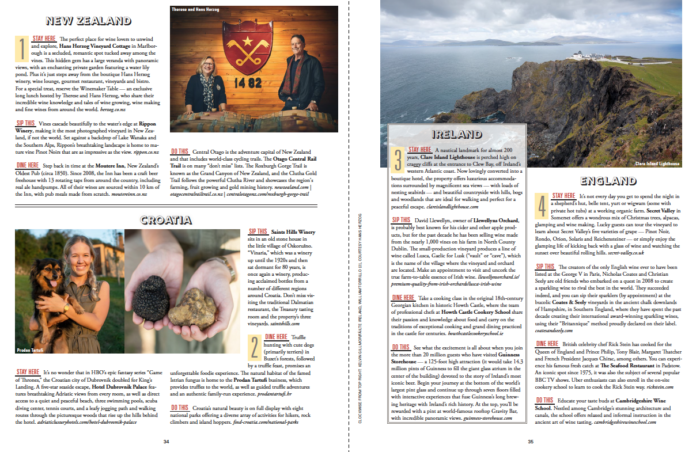
New Zealand, Croatia, Ireland and England — from the Top Experiences: 25 Ways to Enjoy Touring & Tasting, originally published in the spring/summer 2020 issue of Touring & Tasting.

Okanagan Valley, British Columbia; Finger Lakes, New York; Virginia and Michigan — from the Top Experiences: 25 Ways to Enjoy Touring & Tasting, originally published in the spring/summer 2020 issue of Touring & Tasting.
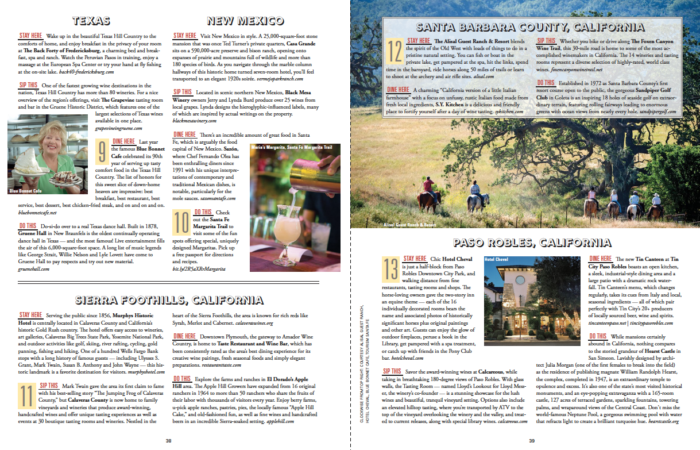
Texas, New Mexico, Sierra Foothills (CA), Santa Barbara County (CA) and Paso Robles (CA) — from the Top Experiences: 25 Ways to Enjoy Touring & Tasting, originally published in the spring/summer 2020 issue of Touring & Tasting.
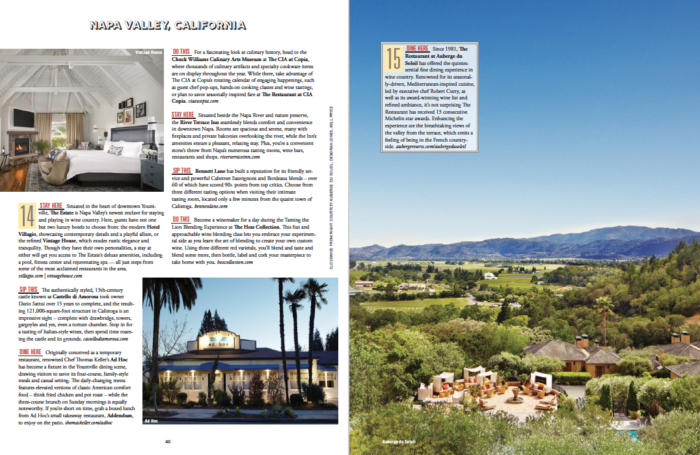
Napa Valley, CA (this section by Hana-Lee Sedgwick) — from the Top Experiences: 25 Ways to Enjoy Touring & Tasting, originally published in the spring/summer 2020 issue of Touring & Tasting.
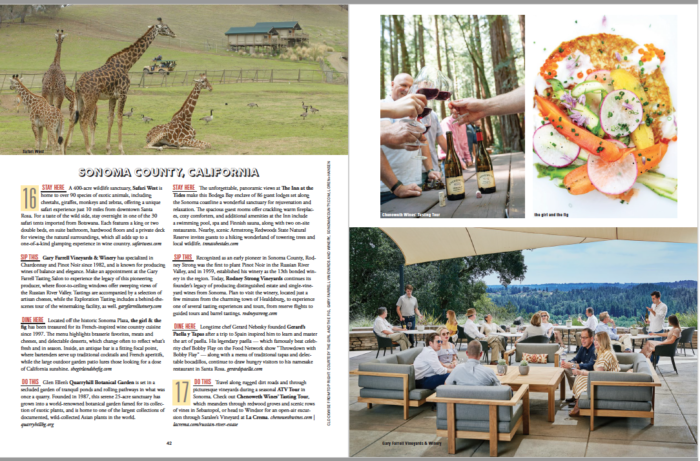
Sonoma County, CA (this section by Hana-Lee Sedgwick) — from the Top Experiences: 25 Ways to Enjoy Touring & Tasting, originally published in the spring/summer 2020 issue of Touring & Tasting.
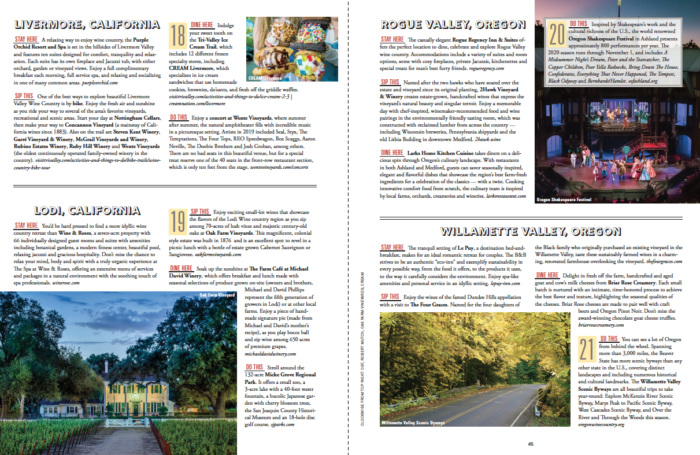
Livermore (CA), Lodi (CA), Rogue Valley (OR) and Willamette Valley (OR) — from the Top Experiences: 25 Ways to Enjoy Touring & Tasting, originally published in the spring/summer 2020 issue of Touring & Tasting.
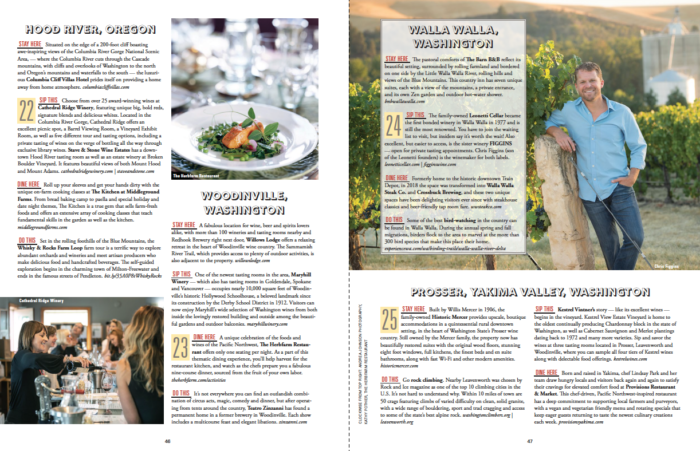
Hood River (OR), Woodinville (WA), Walla Walla (WA) and Prosser, Yakima Valley (WA) — from the Top Experiences: 25 Ways to Enjoy Touring & Tasting, originally published in the spring/summer 2020 issue of Touring & Tasting.
There are so many wonderful travel destinations for wine lovers these days, narrowing down the list to our top 25 experiences was quite a challenge.
Spectacular scenery, gorgeous vineyards and top-notch vino are all essentials, of course. We also tried to come up with a balanced mix of must-sees and more off-the-beaten-track fun activities to reflect the vast array of interests and price points available for today’s trekkers.
Here are but a few of the many, many wonderful, fun and unique ways to stoke your wanderlust and your oenophilia. Whether you’re an experienced traveler or just beginning to develop your wine adventure bucket list, here are 25 destinations that are ripe for the sipping.
New Zealand
STAY HERE The perfect place for wine lovers to unwind and explore, Hans Herzog Vineyard Cottage in Marlborough is a secluded, romantic spot tucked away among the vines. This hidden gem has a large veranda with panoramic views, with an enchanting private garden featuring a water lily pond. Plus it’s just steps away from the boutique Hans Herzog winery, wine lounge, gourmet restaurant, vineyards and bistro. For a special treat, reserve the Winemaker Table — an exclusive long lunch hosted by Therese and Hans Herzog, who share their incredible wine knowledge and tales of wine growing, wine making and fine wines from around the world. herzog.co.nz
SIP THIS Vines cascade beautifully to the water’s edge at Rippon Winery, making it the most photographed vineyard in New Zealand, if not the world. Set against a backdrop of Lake Wanaka and the Southern Alps, Rippon’s breathtaking landscape is home to mature vine Pinot Noirs that are as impressive as the view. rippon.co.nz
DINE HERE Step back in time at the Moutere Inn, New Zealand’s Oldest Pub (circa 1850). Since 2008, the Inn has been a craft beer freehouse with 13 rotating taps from around the country, including real ale handpumps. All of their wines are sourced within 10 km of the Inn, with pub meals made from scratch. moutereinn.co.nz
DO THIS Central Otago is the adventure capital of New Zealand and that includes world-class cycling trails. The Otago Central Rail Trail is on many “don’t miss” lists. The Roxburgh Gorge Trail is known as the Grand Canyon of New Zealand, and the Clutha Gold Trail follows the powerful Clutha River and showcases the region’s farming, fruit growing and gold mining history. newzealand.com |otagocentralrailtrail.co.nz | centralotagonz.com/roxburgh-gorge-trail
Croatia
STAY HERE It’s no wonder that in HBO’s epic fantasy series “Game of Thrones,” the Croatian city of Dubrovnik doubled for King’s Landing. A five-star seaside escape, Hotel Dubrovnik Palace features breathtaking Adriatic views from every room, as well as direct access to a quiet and peaceful beach, three swimming pools, scuba diving center, tennis courts, and a leafy jogging path and walking routes through the picturesque woods that rise up the hills behind the hotel. adriaticluxuryhotels.com/hotel-dubrovnik-palace
SIP THIS Saints Hills Winery sits in an old stone house in the little village of Oskorušno. “Vinaria,” which was a winery up until the 1920s and then sat dormant for 80 years, is once again a winery, producing acclaimed bottles from a number of different regions around Croatia. Don’t miss visiting the traditional Dalmatian restaurant, the Treasury tasting room and the property’s three vineyards. saintshills.com
DINE HERE Truffle hunting with cute dogs (primarily terriers) in Buzet’s forests, followed by a truffle feast, promises an unforgettable foodie experience. The natural habitat of the famed Istrian fungus is home to the Prodan Tartufi business, which provides truffles to the world, as well as guided truffle adventures and an authentic family-run experience. prodantartufi.hr
DO THIS Croatia’s natural beauty is on full display with eight national parks offering a diverse array of activities for hikers, rock climbers and island hoppers. find-croatia.com/national-parks
Ireland
STAY HERE A nautical landmark for almost 200 years, Clare Island Lighthouse is perched high on craggy cliffs at the entrance to Clew Bay, off Ireland’s western Atlantic coast. Now lovingly converted into a boutique hotel, the property offers luxurious accommodations surrounded by magnificent sea views — with loads of nesting seabirds — and beautiful countryside with hills, bogs and woodlands that are ideal for walking and perfect for a peaceful escape. clareislandlighthouse.com
SIP THIS David Llewellyn, owner of Llewellyns Orchard, is probably best known for his cider and other apple products, but for the past decade he has been selling wine made from the nearly 1,000 vines on his farm in North County Dublin. The small-production vineyard produces a line of wine called Lusca, Gaelic for Lusk (“vault” or “cave”), which is the name of the village where the vineyard and orchard are located. Make an appointment to visit and uncork the true farm-to-table essence of Irish wine. llewellynsorchard.ie/premium-quality-from-irish-orchards/lusca-irish-wine
DINE HERE Take a cooking class in the original 18th-century Georgian kitchen in historic Howth Castle, where the team of professional chefs at Howth Castle Cookery School share their passion and knowledge about food and carry on the traditions of exceptional cooking and grand dining practiced in the castle for centuries. howthcastlecookeryschool.ie
DO THIS See what the excitement is all about when you join the more than 20 million guests who have visited Guinness Storehouse — a 125-foot high attraction (it would take 14.3 million pints of Guinness to fill the giant glass atrium in the center of the building) devoted to the story of Ireland’s most iconic beer. Begin your journey at the bottom of the world’s largest pint glass and continue up through seven floors filled with interactive experiences that fuse Guinness’s long brewing heritage with Ireland’s rich history. At the top, you’ll be rewarded with a pint at world-famous rooftop Gravity Bar, with incredible panoramic views. guinness-storehouse.com
England
STAY HERE It’s not every day you get to spend the night in a shepherd’s hut, belle tent, yurt or wigwam (some with private hot tubs) at a working organic farm. Secret Valley in Somerset offers a wondrous mix of Christmas trees, alpacas, glamping and wine making. Lucky guests can tour the vineyard to learn about Secret Valley’s five varieties of grape — Pinot Noir, Rondo, Orion, Solaris and Reichensteiner — or simply enjoy the glamping life of kicking back with a glass of wine and watching the sunset over beautiful rolling hills. secret-valley.co.uk
SIP THIS The creators of the only English wine ever to have been listed at the George V in Paris, Nicholas Coates and Christian Seely are old friends who embarked on a quest in 2008 to create a sparkling wine to rival the best in the world. They succeeded indeed, and you can sip their sparklers (by appointment) at the bucolic Coates & Seely vineyards in the ancient chalk downlands of Hampshire, in Southern England, where they have spent the past decade creating their international award-winning sparkling wines, using their “Britannique” method proudly declared on their label. coatesandseely.com
DINE HERE British celebrity chef Rick Stein has cooked for the Queen of England and Prince Philip, Tony Blair, Margaret Thatcher and French President Jacques Chirac, among others. You can experience his famous fresh catch at The Seafood Restaurant in Padstow. An iconic spot since 1975, it was also the subject of several popular BBC TV shows. Uber enthusiasts can also enroll in the on-site cookery school to learn to cook the Rick Stein way. rickstein.com
DO THIS Educate your taste buds at Cambridgeshire Wine School. Nestled among Cambridge’s stunning architecture and canals, the school offers relaxed and informal instruction in the ancient art of wine tasting. cambridgeshirewineschool.com
Okanagan Valley, British Columbia
STAY HERE An elegant wellness spa inspired by the simple elegance of the Okanagan landscape, Sparkling Hill Resort is the culmination of the vision of Gernot Langes-Swarovski, patriarch of the Swarovski crystal family. A total of 3.5 million Swarovski crystals dance within the resort’s walls, creating an ambiance of calm and serenity with the occasional fiery sparkle. Between the stunning location and holistic treatments, this is an excellent place to relax and refresh. sparklinghill.com
SIP THIS Savor your way along a meandering country road with spectacular views of vineyards, mountains and Okanagan Lake, as you taste your way through more than 20 wineries that draw on the rich terroir of the Naramata Bench. Each winery is dedicated to bringing out the superb local qualities in their wine making, and to providing a personal, relaxed and authentic experience for visitors. naramatabench.com
EAT HERE A partnership between Tinhorn Creek Vineyards and British Columbia culinary legend Manuel Ferreira, Miradoro Restaurant is a lovely place to enjoy panoramic views of the valley with Mediterranean-inspired cuisine emphasizing seasonal, locally sourced ingredients prepared by an award-winning chef. From the authentic forno oven to a diverse wine list (including library wines), this is the place for food lovers to indulge. tinhorn.com/Restaurant
DO THIS The Great Bear Rainforest is a vast area of pristine wilderness that encompasses a quarter of the world’s coastal temperate rainforest. Soak up a whole lot of silence and drink in the lush green surroundings of the only corner of the planet where you can spot the elusive white Kermode bear, also known as the “spirit bear.” hellobc.com
Finger Lakes, New York
STAY HERE Located on the first winery to open on Seneca Lake in 1977, The Inn at Glenora Wine Cellars offers 30 rooms with private patios or balconies and stunning views of the lake and vineyards on the beautifully groomed 40-acre estate of Glenora Wine Cellars. glenora.com
SIP THIS With a community of more than 35 wineries, a distillery, two breweries and a meadery, the Seneca Lake Wine Trail in the heart of New York state’s Finger Lakes region is the largest and most active wine trail in New York. Taste classic, well-known European wine varieties like Riesling, Cabernet Franc, Chardonnay and Grüner Veltliner, alongside unique regional hybrids such as Traminette or Marechal Foch, and classic natives such as Catawba and Niagara. senecalakewine.com
EAT HERE The high end, low brow food at F.L.X. Weinery is an ideal way to enjoy some sustenance between stops on the Seneca Lake Wine Trail. This venture by the husband and wife team Isabel Bogadtke and Christopher Bates is a fascinating amalgamation of their years in the fine dining world (he’s a master sommelier and they also own Element Winery) with fast, casual counter-style service. Think fresh ground burgers with creative toppings like Korean kimchi and miso mayo, and hearty dogs — including house-made brats, chorizo and Italian sausages — with a variety of toppings, most of which are locally sourced. flxwienery.com
DO THIS Dazzle your senses at the home of the largest glass collection in the world. Nearly 50,000 glass objects are on display at the Corning Museum of Glass, which also offers live hot glassmaking and flameworking shows each day, as well as opportunities to work with glass yourself during a Make Your Own Glass experience at The Studio. cmog.org
Virginia
STAY HERE Providing the finest of accommodations since it opened its doors in 1895, The Jefferson Hotel in Richmond, Virginia has been regarded as one of America’s best by countless distinguished guests, including 12 U.S. Presidents, F. Scott and Zelda Fitzgerald, and Elvis Presley. jeffersonhotel.com
SIP THIS Visit the eight wineries located in the Chesapeake Bay wine region, which encompasses the Northern Neck and Middle Peninsula of Virginia. Don’t miss the Chesapeake Bay Trail’s newest member, Rivah Vineyards at the Grove, with 125 scenic acres of farm, woods and riverfront on the Yeocomico River. chesapeakebaywinetrail.com | rivahvineyards.com
EAT HERE Located in the Landsdowne Resort & Spa in Leesburg, Coton & Rye celebrates Virginia’s rich culinary history. Inspired by a farm that stood on the land in the 1700s, this is a tavern with classic Virginia recipes reinvented. lansdowneresort.com
DO THIS Soar among the treetops on the luxurious grounds of Salamander Resort & Spa, home to Empower Adventures’ TreeTop Zip tour in Middleburg. This 20-acre guided experience includes five fast zip lines, two sky bridges and eight stations. Post adventure, enjoy a celebratory glass of wine or a relaxing spa treatment. empoweradventures.com
Michigan
STAY HERE Nestled among the freshwater beaches and hardwood forests of Traverse City, with three championship golf courses, an award-winning spa and restaurant, the 900-acre Grand Traverse Resort and Spa is certainly one of Michigan’s foremost resort destinations. grandtraverseresort.com
SIP THIS Chateau Grand Traverse is one of the oldest and largest wineries and vineyards in northern Michigan. This scenic, family-owned and -operated winery offers guests premium wine tasting, winery tours, lodging and a beautiful setting. Tour the bustling wine cellar to witness firsthand premium wine production from the vine to the bottle. cgtwines.com
EAT HERE There are 32,000 acres of tart cherries planted in Michigan, and Cherry Republic in Glen Arbor is the largest cherry exporter in the world. Take a crooked pathway under the cherry trees and through perennial gardens to the Great Hall, where you can buy 200+ cherry products and sample to your heart’s content. Visit the Winery, and head to the Cherry Public House to enjoy inventive cherry-inspired selections. cherryrepublic.com/locations/glen-arbor
DO THIS Visit Sleeping Bear Dunes National Lakeshore and take the 7.4 mile Pierce Stocking Scenic Drive, looping through the forest and sand dunes and spectacular overlooks of the Sleeping Bear Dunes and Lake Michigan. nps.gov/slbe/planyourvisit/psscenicdrive.htm
Texas
STAY HERE Wake up in the beautiful Texas Hill Country to the comforts of home, and enjoy breakfast in the privacy of your room at The Back Forty of Fredericksburg, a charming bed and breakfast, spa and ranch. Watch the Peruvian Pasos in training, enjoy a massage at the European Spa Center or try your hand at fly fishing at the on-site lake. back40-fredericksburg.com
SIP THIS One of the fastest growing wine destinations in the nation, Texas Hill Country has more than 80 wineries. For a nice overview of the region’s offerings, visit The Grapevine tasting room and bar in the Gruene Historic District, which features one of the largest selections of Texas wines available in one place. grapevineingruene.com
DINE HERE Last year the famous Blue Bonnet Cafe celebrated its 90th year of serving up tasty comfort food in the Texas Hill Country. The list of honors for this sweet slice of down-home heaven are impressive: best breakfast, best restaurant, best service, best dessert, best chicken-fried steak, and on and on and on. bluebonnetcafe.net
DO THIS Do-si-do over to a real Texas dance hall. Built in 1878, Gruene Hall in New Braunfels is the oldest continually operating dance hall in Texas — and the most famous! Live entertainment fills the air of this 6,000-square-foot space. A long list of music legends like George Strait, Willie Nelson and Lyle Lovett have come to Gruene Hall to pay respects and try out new material. gruenehall.com
New Mexico
STAY HERE Visit New Mexico in style. A 25,000-square-foot stone mansion that was once Ted Turner’s private quarters, Casa Grande sits on a 590,000-acre preserve and bison ranch, opening onto expanses of prairie and mountains full of wildlife and more than 180 species of birds. As you navigate through the marble column hallways of this historic home turned seven-room hotel, you’ll feel transported to an elegant 1920s soirée. vermejoparkranch.com
SIP THIS Located in scenic northern New Mexico, Black Mesa Winery owners Jerry and Lynda Burd produce over 25 wines from local grapes. Lynda designs the hieroglyphic-influenced labels, many of which are inspired by actual writings on the property. blackmesawinery.com
DINE HERE There’s an incredible amount of great food in Santa Fe, which is arguably the food capital of New Mexico. Suzan, where Chef Fernando Olea has been enthralling diners since 1991 with his unique interpretations of contemporary and traditional Mexican dishes, is notable, particularly for the mole sauces. sazonsantafe.com
DO THIS Check out the Santa Fe Margarita Trail to visit some of the fun spots offering special, uniquely designed Margaritas. Pick up a free passport for directions and recipes. bit.ly/2R5aXRrMargarita
Sierra Foothills, California
STAY HERE Serving the public since 1856, Murphys Historic Hotel is centrally located in Calaveras County and California’s historic Gold Rush country. The hotel offers easy access to wineries, art galleries, Calaveras Big Trees State Park, Yosemite National Park, and outdoor activities like golf, skiing, river rafting, cycling, gold panning, fishing and hiking. One of a hundred Wells Fargo Bank stops with a long history of famous guests — including Ulysses S. Grant, Mark Twain, Susan B. Anthony and John Wayne — this historic landmark is a favorite destination for visitors. murphyshotel.com
SIP THIS Mark Twain gave the area its first claim to fame with his best-selling story “The Jumping Frog of Calaveras County,” but Calaveras County is now home to family vineyards and wineries that produce award-winning, handcrafted wines and offer unique tasting experiences as well as events at 30 boutique tasting rooms and wineries. Nestled in the heart of the Sierra Foothills, the area is known for rich reds like Syrah, Merlot and Cabernet. calaveraswines.org
DINE HERE Downtown Plymouth, the gateway to Amador Wine Country, is home to Taste Restaurant and Wine Bar, which has been consistently rated as the area’s best dining experience for its creative wine pairings, fresh seasonal foods and simply elegant preparations. restauranttaste.com
DO THIS Explore the farms and ranches in El Dorado’s Apple Hill area. The Apple Hill Growers have expanded from 16 original ranchers in 1964 to more than 50 ranchers who share the fruits of their labor with thousands of visitors every year. Enjoy berry farms, u-pick apple ranches, pastries, pies, the locally famous “Apple Hill Cake,” and old-fashioned fun, as well as fine wines and handcrafted beers in an incredible Sierra-soaked setting. applehill.com
Santa Barbara County, California
STAY HERE The Alisal Guest Ranch & Resort blends the spirit of the Old West with loads of things to do in a pristine natural setting. You can fish or boat in the private lake, get pampered at the spa, hit the links, spend time in the barnyard, ride horses along 50 miles of trails or learn to shoot at the archery and air rifle sites. alisal.com
DINE HERE A charming “California version of a little Italian farmhouse” with a focus on unfussy, rustic Italian food made from fresh local ingredients, S.Y. Kitchen is a delicious and friendly place to fortify yourself after a day of wine tasting. sykitchen.com
SIP THIS Whether you bike or drive along The Foxen Canyon Wine Trail, this 30-mile road is home to some of the most accomplished winemakers in California. The 14 wineries and tasting rooms represent a diverse selection of highly-rated, world class wines. foxencanyonwinetrail.net
DO THIS Established in 1972 as Santa Barbara County’s first resort course open to the public, the gorgeous Sandpiper Golf Club in Goleta is an inspiring 18 holes of seaside golf on extraordinary terrain, featuring rolling fairways leading to enormous greens with ocean views from nearly every hole. sandpipergolf.com
Paso Robles, California
STAY HERE Chic Hotel Cheval is just a half-block from Paso Robles Downtown City Park, and walking distance from fine restaurants, tasting rooms and shops. The horse-loving owners gave the two-story inn an equine theme — each of the 16 individually decorated rooms bears the name and associated photos of historically significant horses plus original paintings and other art. Guests can enjoy the glow of outdoor fireplaces, peruse a book in the Library, get pampered with a spa treatment, or catch up with friends in the Pony Club bar. hotelcheval.com
SIP THIS Savor the award-winning wines at Calcareous, while taking in breathtaking 180-degree views of Paso Robles. With glass walls, the Tasting Room — named Lloyd’s Lookout for Lloyd Messer, the winery’s co-founder — is a stunning showcase for the lush wines and beautiful, tranquil vineyard setting. Options also include an elevated hilltop tasting, where you’re transported by ATV to the top of the vineyard overlooking the winery and the valley, and treated to current releases, along with special library wines. calcareous.com
DINE HERE The new Tin Canteen at Tin City Paso Robles boasts an open kitchen, a sleek, industrial-style dining area and a large patio with a dramatic rock waterfall. Tin Canteen’s menu, which changes regularly, takes its cues from Italy and local, seasonal ingredients — all of which pair perfectly with Tin City’s 20+ producers of locally sourced beer, wine and spirits. tincanteenpaso.net | tincitypasorobles.com
DO THIS While mansions certainly abound in California, nothing compares to the storied grandeur of Hearst Castle in San Simeon. Lavishly designed by architect Julia Morgan (one of the first females to break into the field) as the residence of publishing magnate William Randolph Hearst, the complex, completed in 1947, is an extraordinary temple to opulence and excess. It’s also one of the state’s most visited historical monuments, and an eye-popping extravaganza with a 165-room castle, 127 acres of terraced gardens, sparkling fountains, towering palms, and wraparound views of the Central Coast. Don’t miss the world-famous Neptune Pool, a gorgeous swimming pool with water that refracts light to create a brilliant turquoise hue. hearstcastle.org
Livermore, California
STAY HERE A relaxing way to enjoy wine country, the Purple Orchid Resort and Spa is set in the hillsides of Livermore Valley and features ten suites designed for comfort, tranquility and relaxation. Each suite has its own fireplace and Jacuzzi tub, with either orchard, garden or vineyard views. Enjoy a full complimentary breakfast each morning, full service spa, and relaxing and socializing in one of many common areas. purpleorchid.com
SIP THIS One of the best ways to explore beautiful Livermore Valley Wine Country is by bike. Enjoy the fresh air and sunshine as you ride your way to several of the area’s favorite vineyards, recreational and scenic areas. Start your day at Nottingham Cellars, then make your way to Concannon Vineyard (a mainstay of California wines since 1883). Also on the trail are Steven Kent Winery, Garré Vineyard & Winery, McGrail Vineyards and Winery, Rubino Estates Winery, Ruby Hill Winery and Wente Vineyards (the oldest continuously operated family-owned winery in the country). visittrivalley.com/activities-and-things-to-do/bike-trails/winecountry-bike-tour
DINE HERE Indulge your sweet tooth on the Tri-Valley Ice Cream Trail, which includes 12 different frozen specialty stores, including CREAM Livermore, which specializes in ice cream sandwiches that use homemade cookies, brownies, do’sants, and fresh off the griddle waffles. visittrivalley.com/activities-and-things-to-do/ice-cream-2-3 | creamnation.com/livermore
DO THIS Enjoy a concert at Wente Vineyards, where summer after summer, the natural amphitheater fills with incredible music in a picturesque setting. Artists in 2019 included Seal, Styx, The Temptations, The Four Tops, REO Speedwagon, Boz Scaggs, Aaron Neville, The Doobie Brothers and Josh Groban, among others. There are no bad seats in this beautiful venue, but for a special treat reserve one of the 40 seats in the front-row restaurant section, which is only ten feet from the stage. wentevineyards.com/concerts
Lodi, California
STAY HERE You’d be hard pressed to find a more idyllic wine country retreat than Wine & Roses, a seven-acre property with 66 individually designed guest rooms and suites with amenities including botanical gardens, a modern fitness center, beautiful pool, relaxing jacuzzi and gracious hospitality. Don’t miss the chance to relax your mind, body and spirit with a truly organic experience at The Spa at Wine & Roses, offering an extensive menu of services and packages in a natural environment with the soothing touch of spa professionals. winerose.com
SIP THIS Enjoy exciting small-lot wines that showcase the flavors of the Lodi Wine country region as you sip among 70-acres of lush vines and majestic century-old oaks at Oak Farm Vineyards. This magnificent, colonial style estate was built in 1876 and is an excellent spot to revel in a picnic lunch with a bottle of estate grown Cabernet Sauvignon or Sangiovese. oakfarmvineyards.com
DINE HERE Soak up the sunshine at The Farm Café at Michael David Winery, which offers breakfast and lunch made with seasonal selections of produce grown on-site (owners and brothers, Michael and David Phillips represent the fifth generation of growers in Lodi) or at other local farms. Enjoy a piece of handmade signature pie (made from Michael and David’s mother’s recipe), as you play bocce ball and sip wine among 650 acres of premium grapes. michaeldavidwinery.com
DO THIS Stroll around the 132-acre Micke Grove Regional Park. It offers a small zoo, a 3-acre lake with a 40-foot water fountain, a bucolic Japanese garden with cherry blossom trees, the San Joaquin County Historical Museum and an 18-hole disc golf course. sjparks.com
Rogue Valley, Oregon
STAY HERE The casually elegant Rogue Regency Inn & Suites offers the perfect location to dine, celebrate and explore Rogue Valley wine country. Accommodations include a variety of suites and room options, some with cozy fireplaces, private Jacuzzis, kitchenettes and special treats for man’s best furry friends. rogueregency.com
SIP THIS Named after the two hawks who have soared over the estate and vineyard since its original planting, 2Hawk Vineyard & Winery creates estate-grown, handcrafted wines that express the vineyard’s natural beauty and singular terroir. Enjoy a memorable day with chef-inspired, winemaker-recommended food and wine pairings in the environmentally friendly tasting room, which was constructed with reclaimed lumber from across the country — including Wisconsin breweries, Pennsylvania shipyards and the old Lithia Building in downtown Medford. 2hawk.wine
DINE HERE Larks Home Kitchen Cuisine takes diners on a delicious spin through Oregon’s culinary landscape. With restaurants in both Ashland and Medford, guests can savor seasonally inspired, elegant and flavorful dishes that showcase the region’s best farm-fresh ingredients for a celebration of the classics — with a twist. Cooking innovative comfort food from scratch, the culinary team is inspired by local farms, orchards, creameries and wineries. larksrestaurant.com
DO THIS Inspired by Shakespeare’s work and the cultural richness of the U.S., the world renowned Oregon Shakespeare Festival in Ashland presents approximately 800 performances per year. The 2020 season runs through November 1, and includes A Midsummer Night’s Dream, Peter and the Starcatcher, The Copper Children, Poor Yella Rednecks, Bring Down The House, Confederates, Everything That Never Happened, The Tempest, Black Odyssey and Bernhardt/Hamlet. osfashland.org
Willamette Valley, Oregon
STAY HERE The tranquil setting of Le Puy, a destination bed-and-breakfast, makes for an ideal romantic retreat for couples. The B&B strives to be an authentic “eco-inn” and exemplify sustainability in every possible way, from the food it offers, to the products it uses, to the way it carefully considers the environment. Enjoy spa-like amenities and personal service in an idyllic setting. lepuy-inn.com
SIP THIS Enjoy the wines of the famed Dundee Hills appellation with a visit to The Four Graces. Named for the four daughters of the Black family who originally purchased an existing vineyard in the Willamette Valley, taste these sustainably farmed wines in a charming, renovated farmhouse overlooking the vineyard. thefourgraces.com
DINE HERE Delight in fresh off the farm, handcrafted and aged goat and cow’s milk cheeses from Briar Rose Creamery. Each small batch is nurtured with an intimate, time-honored process to achieve the best flavor and texture, highlighting the seasonal qualities of the cheeses. Briar Rose cheeses are made to pair well with craft beers and Oregon Pinot Noir. Don’t miss the award-winning chocolate goat cheese truffles. briarrosecreamery.com
DO THIS You can see a lot of Oregon from behind the wheel. Spanning more than 3,000 miles, the Beaver State has more scenic byways than any other state in the U.S., covering distinct landscapes and including numerous historical and cultural landmarks. The Willamette Valley Scenic Byways are all beautiful trips to take year-round: Explore McKenzie River Scenic Byway, Marys Peak to Pacific Scenic Byway, West Cascades Scenic Byway, and Over the River and Through the Woods this season. oregonwinecountry.org
Hood River, Oregon
STAY HERE Situated on the edge of a 200-foot cliff boasting awe-inspiring views of the Columbia River Gorge National Scenic Area — where the Columbia River cuts through the Cascade mountains, with cliffs and overlooks of Washington to the north and Oregon’s mountains and waterfalls to the south — the luxurious Columbia Cliff Villas Hotel prides itself on providing a home away from home atmosphere. columbiacliffvillas.com
SIP THIS Choose from over 25 award-winning wines at Cathedral Ridge Winery, featuring unique big, bold reds, signature blends and delicious whites. Located in the Columbia River Gorge, Cathedral Ridge offers an excellent picnic spot, a Barrel Viewing Room, a Vineyard Exhibit Room, as well as five different tour and tasting options, including a private tasting of wines on the verge of bottling all the way through exclusive library wines. Stave & Stone Wine Estates has a downtown Hood River tasting room as well as an estate winery at Broken Boulder Vineyard. It features beautiful views of both Mount Hood and Mount Adams. cathedralridgewinery.com | staveandstone.com
DINE HERE Roll up your sleeves and get your hands dirty with the unique on-farm cooking classes at The Kitchen at Middleground Farms. From bread baking camp to paella and special holiday and date night themes, The Kitchen is a true gem that sells farm-fresh foods and offers an extensive array of cooking classes that teach fundamental skills in the garden as well as the kitchen. middlegroundfarms.com
DO THIS Set in the rolling foothills of the Blue Mountains, the Whisky & Rocks Farm Loop farm tour is a terrific way to explore abundant orchards and wineries and meet artisan producers who make delicious food and handcrafted beverages. The self-guided exploration begins in the charming town of Milton-Freewater and ends in the famous streets of Pendleton. bit.ly/35A0P8tWhiskyRocks
Woodinville, Washington
STAY HERE A fabulous location for wine, beer and spirits lovers alike, with more than 100 wineries and tasting rooms nearby and Redhook Brewery right next door, Willows Lodge offers a relaxing retreat in the heart of Woodinville wine country. The Sammamish River Trail, which provides access to plenty of outdoor activities, is also adjacent to the property. willowslodge.com
SIP THIS One of the newest tasting rooms in the area, Maryhill Winery — which also has tasting rooms in Goldendale, Spokane and Vancouver — occupies nearly 10,000 square feet of Woodinville’s historic Hollywood Schoolhouse, a beloved landmark since its construction by the Derby School District in 1912. Visitors can now enjoy Maryhill’s wide selection of Washington wines from both inside the lovingly restored building and outside among the beautiful gardens and outdoor balconies. maryhillwinery.com
DINE HERE A unique celebration of the foods and wines of the Pacific Northwest, The Herbfarm Restaurant offers only one seating per night. As a part of this thematic dining experience, you’ll help harvest for the restaurant kitchen, and watch as the chefs prepare you a fabulous nine-course dinner, sourced from the fruit of your own labor. theherbfarm.com/activities
DO THIS It’s not everywhere you can find an outlandish combination of circus acts, magic, comedy and dinner, but after operating from tents around the country, Teatro Zinzanni has found a permanent home in a former brewery in Woodinville. Each show includes a multicourse feast and elegant libations. zinzanni.com
Walla Walla, Washington
STAY HERE The pastoral comforts of The Barn B&B reflect its beautiful setting, surrounded by rolling farmland and bordered on one side by the Little Walla Walla River, rolling hills and views of the Blue Mountains. This country inn has seven unique suites, each with a view of the mountains, a private entrance, and its own Zen garden and outdoor hot-water shower. bnbwallawalla.com
SIP THIS The family-owned Leonetti Cellar became the first bonded winery in Walla Walla in 1977 and is still the most renowned. You have to join the waiting list to visit, but insiders say it’s worth the wait! Also excellent, but easier to access, is the sister winery FIGGINS— open for private tasting appointments. Chris Figgins (son of the Leonetti founders) is the winemaker for both labels. leonetticellar.com | figginswine.com
DINE HERE Formerly home to the historic downtown Train Depot, in 2018 the space was transformed into Walla Walla Steak Co. and Crossbuck Brewing, and these two unique spaces have been delighting visitors ever since with steakhouse classics and beer-friendly tap room fare. wwsteakco.com
DO THIS Some of the best bird-watching in the country can be found in Walla Walla. During the annual spring and fall migrations, birders flock to the area to marvel at the more than 300 bird species that make this place their home. experiencewa.com/wa/birding-trails/walla-walla-river-delta
Prosser, Yakima Valley, Washington
STAY HERE Built by Willis Mercer in 1906, the family-owned Historic Mercer provides upscale, boutique accommodations in a quintessential rural downtown setting, in the heart of Washington State’s Prosser wine country. Still owned by the Mercer family, the property now has beautifully restored suites with the original wood floors, stunning eight foot windows, full kitchens, the finest beds and en suite bathrooms, along with fast Wi-Fi and other modern amenities. historicmercer.com
DO THIS Go rock climbing. Nearby Leavenworth was chosen by Rock and Ice magazine as one of the top 10 climbing cities in the U.S. It’s not hard to understand why. Within 10 miles of town are 50 crags featuring climbs of varied difficulty on clean, solid granite, with a wide range of bouldering, sport and trad cragging and access to some of the state’s best alpine rock. washingtonclimbers.org | leavenworth.org
SIP THIS Kestrel Vintner’s story — like its excellent wines — begins in the vineyard. Kestrel View Estate Vineyard is home to the oldest continually producing Chardonnay block in the state of Washington, as well as Cabernet Sauvignon and Merlot plantings dating back to 1972 and many more varieties. Sip and savor the wines at three tasting rooms located in Prosser, Leavenworth and Woodinville, where you can sample all four tiers of Kestrel wines along with delectable food offerings. kestrelwines.com
DINE HERE Born and raised in Yakima, chef Lindsay Park and her team draw hungry locals and visitors back again and again to satisfy their cravings for elevated comfort food at Provisions Restaurant & Market. This chef-driven, Pacific Northwest-inspired restaurant has a deep commitment to supporting local farmers and purveyors, with a vegan and vegetarian friendly menu and rotating specials that keep eager guests returning to taste the newest culinary creations each week. provisionsyakima.com
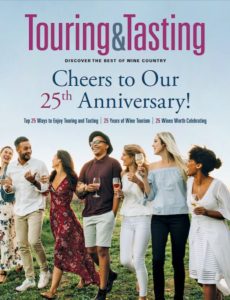 Originally published in the spring/summer 2020 issue of Touring & Tasting. Click here to read this story and more! TT-SP20.digital
Originally published in the spring/summer 2020 issue of Touring & Tasting. Click here to read this story and more! TT-SP20.digital
 Originally published in the spring/summer 2020 issue of Touring & Tasting. Click here to read this story and more! TT-SP20.digital
Originally published in the spring/summer 2020 issue of Touring & Tasting. Click here to read this story and more! TT-SP20.digital
